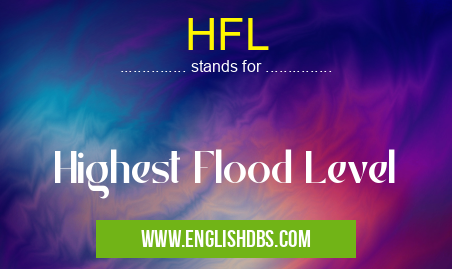What does HFL mean in HYDROLOGY
HFL stands for Highest Flood Level, which is the maximum height reached by a body of water during a flood event. It is an important factor to consider when predicting and preparing for floods as it can help us identify necessary precautions needed to protect our safety and belongings. In this article, we will discuss HFLs in more detail, including how they are calculated and why they should be taken into consideration when dealing with flood events.

HFL meaning in Hydrology in Academic & Science
HFL mostly used in an acronym Hydrology in Category Academic & Science that means Highest Flood Level
Shorthand: HFL,
Full Form: Highest Flood Level
For more information of "Highest Flood Level", see the section below.
Essential Questions and Answers on Highest Flood Level in "SCIENCE»HYDROLOGY"
What is the Highest Flood Level?
The Highest Flood Level (HFL) is the highest flood depth that can be expected to occur at a given area during a specific period of time. HFL takes into account all possible factors, including but not limited to storm surge, rainfall, melting snowpack and groundwater flow.
How does HFL affect us?
Knowing the HFL for your area allows you to understand the risk associated with flooding in your area and take the necessary precautions for safety purposes. It also helps local authorities plan for emergency response tactics, such as evacuation routes and temporary shelters in case of a flood event.
How often is HFL updated?
The frequency at which HFL is updated may vary depending on environmental or man-made changes affecting an area or region's hydrological patterns. Generally speaking, this data should be updated every five to ten years to accommodate any potential changes to the watershed system.
Who uses HFL information?
Various stakeholders use Highest Flood Level information, such as local Civil Protection departments, insurance companies, farmers, private landowners and government agencies. This data can also be used by architects when designing buildings close to waterbodies or areas susceptible to flooding, as well as informing climate change mitigation strategies.
What factors are taken into consideration when calculating HFL?
When calculating Highest Flood Level data various factors are taken into consideration such as weather conditions (e.g., temperature and wind speed), topography of the region (e.g., elevation), amount of precipitation received in a certain time frame (e.g., last six months) and existing rainfall trends since past floods events have occurred in the same area.
Is there any software available to calculate HFL?
Yes! There are various software packages available which allow users to estimate their own local Highest Flood Levels based on geographic information and hydrological modeling techniques. Such programs provide users with accurate predictions of potential future floods within an area or municipality while taking into consideration multiple environmental factors.
Are these predictions always accurate?
While these calculations provide invaluable insight regarding potential flood risks they may not always reflect actual occurrences due to variance in weather patterns and other environmental influences over longer periods of time.
Does knowing my local Highest Flood Levels guarantee safety against all flooding risks?
No - while it provides valuable information about potential flooding risks it does not offer complete protection against flooding due to unforeseen extreme events or changes in climate patterns.
Can I use historic data from previous flooding events when calculating my local HFL?
Yes! Previous flood levels can be used as evidence when constructing new predictive models by incorporating them along with real-time hydro-meteorological data from other sources.
What kind of resources should I use when trying to find reliable HFL data for my area?
It is recommended that you refer to your regional civil protection unit's website for official records pertaining to predicted Highest Flood Levels within your municipality or vicinity. Additionally you can access public databases such as National Oceanic and Atmospheric Administration's Advanced Hydrologic Prediction Service (AHPS) which contains high quality historical data regarding past floods across North America.
Final Words:
In conclusion, HFL stands for Highest Flood Level and is used by hydrologists to estimate the maximum possible reach of water during a flood event based on historic data as well as current weather conditions and nearby land use information near rivers or lakes prone to flooding activities. Knowing what this value is can help us better prepare for floods and protect ourselves from potential damages caused by them due to higher than expected water intensities reaching certain areas under specific circumstances.
